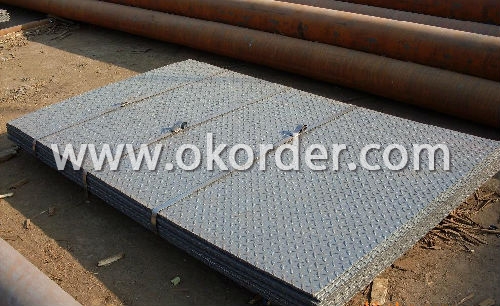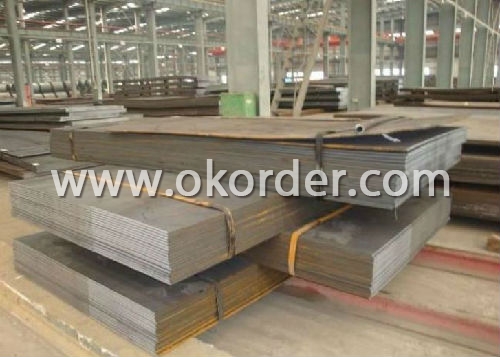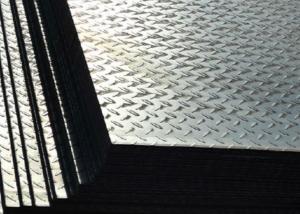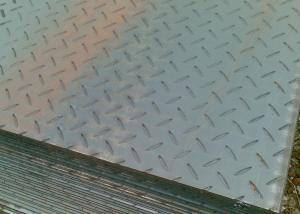High Quality Hot Rolled Steel Sheet
- Loading Port:
- Xingang Port
- Payment Terms:
- TT or LC
- Min Order Qty:
- 100MT m.t.
- Supply Capability:
- 100000MT m.t./month
OKorder Service Pledge
OKorder Financial Service
You Might Also Like
Specification of Hot Rolled Checkered Steel Plate:
1.Advantages of our Hot Rolled Checkered Steel Plate:
a) The unfairness of our checkered steel sheet must be less than 10mm each meter
b) The surface of our hot rolled checkered steel plate is free from bubble, scab, crack, fold, edge delamination and so on.
c) The height of our hot rolled checkered steel plate will be maintained between 0.2~0.3 times to thickness of steel substrate, but more than 0.5mm at least.
2. Other details of Hot Rolled Checkered Steel Plate
Standard | GB T 3277, DIN 5922 |
Grade | Q235, S235JR |
Thickness | 2.5-8.0mm |
Width | 1000-1600mm |
Length | 4000-8000mm |
Note: Dimension of our hot rolled checkered steel sheet can be made according to your requirements, we can futher discuss it.
3. The regular sections we provide are shown in the below table:
Base Thickness(MM) | Allowed Tolerance of Base Thickness(%) | Theoretical Mass (KG/M²) | ||
The Pattern | ||||
Rhombus | Beam | Pea | ||
2.5 | ±0.3 | 21.6 | 21.3 | 21.1 |
3.0 | ±0.3 | 25.6 | 24.4 | 24.3 |
3.5 | ±0.3 | 29.5 | 28.4 | 28.3 |
4.0 | ±0.4 | 33.4 | 32.4 | 32.3 |
4.5 | ±0.4 | 37.3 | 36.4 | 36.2 |
5.0 | 0.4~-0.5 | 42.3 | 40.5 | 40.2 |
5.5 | 0.4~-0.5 | 46.2 | 44.3 | 44.1 |
6.0 | 0.5~-0.6 | 50.1 | 48.4 | 48.1 |
7.0 | 0.6~-0.7 | 59.0 | 52.5 | 52.4 |
8.0 | 0.7~-0.8 | 66.8 | 56.4 | 56.2 |
4. Chemical Composition of Hot Rolled Checkered Steel Plate:
Chemical Composition | ||||||||||
C | Si | Mn | P | S | ||||||
Q345B | ≤0.20 | ≤0.55 | 1.00-1.60 | ≤0.040 | ≤0.040 | |||||
Q345C | ≤0.20 | ≤0.55 | 1.00-1.60 | ≤0.035 | ≤0.035 | |||||
Q345D | ≤0.18 | ≤0.55 | 1.00-1.60 | ≤0.030 | ≤0.030 | |||||
Note: Here, we just take the hot rolled checkered steel sheet according to Q345B, Q345C and Q345D as example. We are also able to provide SGS test report for checkered steel sheet as per other material grade.
Applications of Hot Rolled Checkered Steel Plate:
1.Definition: The hot rolled steel sheet with raised pattern on surface. The raised pattern could be shaped as rhombus,bean or pea. There is not only one kind of pattern on the checkered steel sheet, but also a complex of two or more than two kinds of pattern on surface of one checkered steel sheet. It also could be called as grid steel sheet.
2.Character: The Hot Rolled Checkered Steel Plate possesses a variet of advantages, such as beauty in appearance,skip resistance and saving steel material.Generally speaking,in order to test the mechanical property or the quality of hot rolled checkered steel sheet, the shaping rate and the pattern height should be tested primarily.
3. In conclusion, the hot rolled checkered steel plate can usually be used in the industry of ship-building,boiler,automobil,tractor,train- building and architecture. In details, there are many demands for hot rolled checkered steel plate to make floor,ladder at workshop,work frame pedal,ship deck,car floor and so on.
Package & Delivery of Hot Rolled Checkered Steel Plate:
1. The items to be prepared for packing include: narrow steel strip, crude steel belt or edge angle steel, kraft paper or galvanized sheet.
2. The hot rolled checkered steel plate should be wrapped with kraft paper or galvanized sheet ouside, and it should be bundled with narrow steel strip, three or two narrow steel strip in longitudinal direction,and the other three or two strips in transverse direction. Furthermore, in order to fix the hot rolled checkered steel plate and avoid the strip at edge shall be broken, the crude steel belt cut into square should be put under the narrow steel strip on the edge. Of course, the hot rolled checkered steel plate could be bundled without kraft paper or galvanized sheet. It depends on customer’s requirement.
3. In consideration of the transportaion from mill to loading port, the truck will be usually used. And the maximum quantity for each truck is 40mt.
4. All in all, we could do in accordance with customer's request.


Production Flow of Hot Rolled Checkered Steel Plate:
1.The steel raw materials are first melted in an electric furnace. They are subjected to at least 12 hours of intense heat.
2.The mixture is cast into either large rectangular blooms, slabs or bar-like billets, before taking on a semisolid form.
This initial form of steel is then processed via forming operations that include hot rolling into bars, wires, plates and slabs.
3.The steel is subjected to annealing. This is a heat treatment in which the metal is first heated and then cooled under extreme, controlled conditions. The metal is thus treated for internal stresses and is duly softened and strengthened. This processing is also referred to as 'age hardening'. It requires careful monitoring of temperature and heating and cooling times. The aging temperature affects metal properties massively; while lower temperatures cause high strength and low fracture toughness (i.e., more brittle than ductile), higher temperatures result in a tougher material of lower strength (i.e., more ductile than brittle). Rapid cooling can produce a tough steel with no significant loss in strength. The heat treatment given to stainless steel depends on the type and grade of steel being produced.
4. Annealing or the heat treatment can lead to the development of a precipitate, known as scale. The scale can be removed via several methods, such as pickling, (nitric-hydrofluoric acid bath),electrocleaning(application of an electric current, using phosphoric acid and a cathode), etc.
5. Descaling of the material is introduced into the manufacturing process at different times, depending on the type of steel being produced. While the bar and wire forms have to be additionally treated with hot rolling,forging and extruding, the sheet and strip forms go through annealing after hot rolling.
6. Cutting operations in the manufacturing process are essential in obtaining the desired shape and size of the end product. Mechanical cutting involves the use of guillotine knives and high-speed steel blades for blanking (punching out the shape by shearing) and nibbling (cutting out a series of overlapping holes). It is also cut via flame cutting, a process that involves the use of a flame generated by oxygen, propane and iron powder. The plasma jet cutting method uses an ionized gas column to melt and cut the metal.
6. Manufacturing end products involve further shaping via heat-rolling, pressing, forging and extrusion. The material is then joined via welding and given the desired shape.
- Q:Are the steel sheets suitable for HVAC applications?
- Yes, steel sheets are suitable for HVAC applications. Steel has excellent strength and durability, making it ideal for use in HVAC systems where it can withstand high temperatures, pressure, and corrosive environments. Additionally, steel sheets can be easily fabricated and shaped to meet specific requirements of HVAC components such as ductwork, heat exchangers, and ventilation systems.
- Q:What are the different hardness levels available for steel sheets?
- The different hardness levels available for steel sheets range from soft to very hard, with common options being mild steel, hot-rolled steel, cold-rolled steel, and stainless steel. These hardness levels determine the steel's ability to resist deformation and wear, making it suitable for various applications based on the required strength and durability.
- Q:What are the weight considerations for steel sheets?
- Weight considerations for steel sheets vary depending on the specific application and desired outcomes. Here are a few key points to consider: 1. Thickness: The thickness of a steel sheet greatly affects its weight. Thicker sheets generally weigh more, while thinner sheets weigh less. It is important to choose a thickness that meets the structural requirements of the project while considering weight limitations. 2. Strength requirements: Different applications require steel sheets of varying strength levels. High-strength steel sheets are often thicker and heavier, while lower strength sheets can be thinner and lighter. Understanding the strength requirements of the project is crucial in determining the appropriate weight of the steel sheets. 3. Transportation and handling: The weight of steel sheets impacts their ease of transportation and handling. Heavier sheets require more labor and equipment for lifting, loading, and unloading. Moreover, transport vehicles have weight limits that need to be considered when selecting steel sheet sizes. 4. Structural limitations: The weight of steel sheets can affect the overall structural design. In some cases, lighter sheets may be preferred to reduce the load on supporting structures. However, in other scenarios, heavier sheets may be necessary to provide the required strength and stability. 5. Cost considerations: The weight of steel sheets can also impact the overall cost of a project. Heavier sheets typically cost more due to the increased material required and the additional handling expenses. Therefore, it is essential to strike a balance between weight, cost, and performance to optimize the project's budget. Overall, weight considerations for steel sheets are crucial in determining the appropriate thickness, strength, transportation requirements, structural design, and cost-effectiveness of a project. By carefully evaluating these factors, one can select steel sheets that meet the specific needs while ensuring the optimal weight for the desired outcome.
- Q:Are steel sheets resistant to bending or deformation?
- Yes, steel sheets are generally resistant to bending or deformation due to their high tensile strength and rigidity.
- Q:Can steel sheets withstand high temperatures?
- Yes, steel sheets can withstand high temperatures.
- Q:What is the difference between a HRPO and HRSPO steel sheet?
- The main difference between a HRPO (Hot Rolled Pickled and Oiled) and HRSPO (Hot Rolled Skin Pass) steel sheet lies in the manufacturing process and the resulting properties of the two types of sheets. HRPO steel sheets are produced by hot rolling a steel slab and then subjecting it to a pickling process where the surface scale is removed using an acid bath. After pickling, the steel sheet is then oiled to provide a protective coating. The pickling process imparts a clean, smooth surface to the sheet, while the oiling helps prevent corrosion and improve formability. HRPO sheets are typically used in applications that require good surface finish and paintability. On the other hand, HRSPO steel sheets undergo an additional skin pass rolling process after pickling and oiling. This process involves passing the sheet through a set of rolls to further improve its surface quality, resulting in a smoother and more uniform surface finish compared to HRPO sheets. The skin pass process also imparts better flatness and dimensional accuracy to the sheet. HRSPO sheets are commonly used in applications that demand higher surface quality, such as automotive panels, appliances, and electrical enclosures. In summary, while both HRPO and HRSPO steel sheets are pickled and oiled, the additional skin pass rolling step in the manufacturing process of HRSPO sheets enhances their surface quality, flatness, and dimensional accuracy, making them suitable for more demanding applications.
- Q:What is the difference between a galvanized and stainless steel sheet?
- A galvanized steel sheet is coated with a layer of zinc to protect it from rust and corrosion, while a stainless steel sheet is made from an alloy of steel and chromium that naturally resists corrosion. This means that a galvanized steel sheet is more susceptible to rust over time, while a stainless steel sheet is more durable and has a longer lifespan.
- Q:Are steel sheets resistant to fire?
- Yes, steel sheets are highly resistant to fire due to their high melting point and the ability to conduct heat away quickly, which helps in preventing the spread of fire.
- Q:Can steel sheets withstand extreme weather conditions?
- Yes, steel sheets are designed to withstand extreme weather conditions. Steel is known for its strength and durability, making it an ideal material for withstanding harsh weather elements such as high winds, heavy rain, snow, and extreme temperatures. Steel sheets are often used in construction, roofing, and outdoor applications where they are exposed to various weather conditions. Additionally, steel sheets can be coated with protective layers such as galvanized or painted finishes, which further enhance their resistance to corrosion and weathering. Overall, steel sheets are highly reliable and can endure extreme weather conditions with minimal damage or deterioration.
- Q:Can steel sheets be welded or joined together?
- Yes, steel sheets can be welded or joined together. Welding is a common method used to join steel sheets together. It involves melting the edges of the sheets and then allowing them to cool and solidify, creating a strong bond between the two sheets. Welding is an effective way to join steel sheets as it provides a durable and permanent connection that can withstand high levels of stress and load. Additionally, other methods such as riveting, bolting, and adhesive bonding can also be used to join steel sheets together depending on the specific application and requirements.
1. Manufacturer Overview |
|
|---|---|
| Location | Qianan, China |
| Year Established | 2005 |
| Annual Output Value | Above US$ 1,300 Million |
| Main Markets | Mid East; Eastern Europe; North America |
| Company Certifications | |
2. Manufacturer Certificates |
|
|---|---|
| a) Certification Name | |
| Range | |
| Reference | |
| Validity Period | |
3. Manufacturer Capability |
|
|---|---|
| a)Trade Capacity | |
| Nearest Port | Tianjin |
| Export Percentage | 40% - 60% |
| No.of Employees in Trade Department | 21-50 People |
| Language Spoken: | English; Chinese |
| b)Factory Information | |
| Factory Size: | Above 800,000 square meters |
| No. of Production Lines | Above 10 |
| Contract Manufacturing | OEM Service Offered; |
| Product Price Range | High; Average |
Send your message to us
High Quality Hot Rolled Steel Sheet
- Loading Port:
- Xingang Port
- Payment Terms:
- TT or LC
- Min Order Qty:
- 100MT m.t.
- Supply Capability:
- 100000MT m.t./month
OKorder Service Pledge
OKorder Financial Service
Similar products
New products
Hot products
Related keywords






























